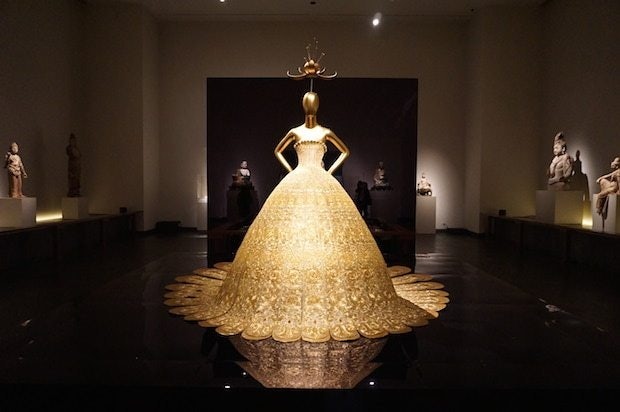
A gown by designer Guo Pei at the Costume Institute's new exhibit, "China: Through the Looking Glass." (Cheryl Zhao/Jing Daily)
While media coverage of this year’s Met Gala focused mainly on the attention-grabbing couture worn by top celebrities like Kim Kardashian, Beyoncé, and Rihanna (and Chinese media closely followed Chinese celebrities), the true star of the event has always been the Metropolitan Museum of Art’s annual exhibition being celebrated by the gala. This year’s massive exhibit, “China: Through the Looking Glass,” takes over not only the museum’s Costume Institute, but also its East Asian galleries with a mixed-medium presentation that examines the ways in which global fashion designers have been influenced by Chinese aesthetics (or what they imagined were Chinese elements). Curated by Andrew Bolton with filmmaker Wong Kar-wai serving as the artistic director, the exhibit features over 140 couture garments displayed alongside film clips and Chinese art and antiques that served as the inspirations for the designs.
At the May 4 press preview ahead of the Met Gala, we talked to Bolton to learn more about the concepts behind the exhibit, including the focus on Western labels' interest in Chinoiserie, how it addresses stereotypes found in many old films that influenced the designs, and why fashion designers have been so obsessed with China throughout history.
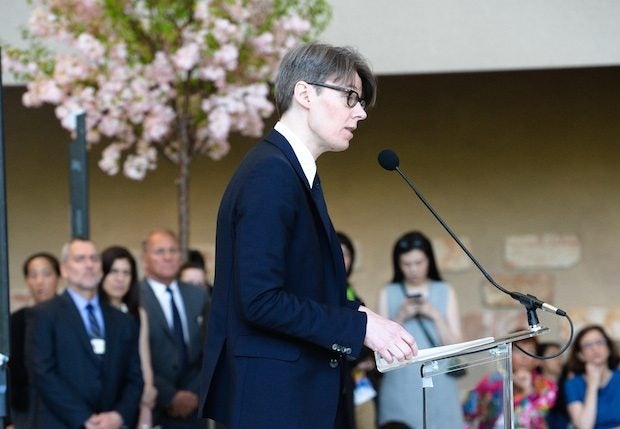
Andrew Bolton, the curator of the Costume Institute's exhibit "China: Through the Looking Glass," at the exhibition's preview on May 4, 2015. (Courtesy Photo)
As we can see from the exhibit, an enormous number of Western designers have incorporated Chinese elements into their creations throughout the years. Why do you think this trend has been so prevalent over such a long span of time?#
It varies. Sometimes, some of the inspirations come through cultural events. In the 1920s, when the Dunhuang caves were being excavated, it caused a huge trend in Chinoiserie. Again in 1997, with the handover of Hong Kong to China, there were so many designers being inspired by China: Karl Lagerfeld at Chanel, Miuccia Prada, Dries Van Noten. I think sometimes it’s triggered by cultural events; sometimes by exhibitions that are staged in cities. But I think part of it is just the ongoing romance of China in designers’ imaginations. I think a lot of designers are not inspired by the real China—they’re inspired by this fictional China that just really exists as a Western fantasy, and that’s really what you’re seeing with the garments here, is this mixture of some factual elements, but also some things which are very distant from reality.
Which particular Chinese motifs did you find were most popular with the designers selected?#
Dragon, for sure. You see it obviously in every art form in China—blue and white porcelain, bronzes, silk robes—so it’s a symbol that has come to represent China for many designers. The color red is another signifier of China. There are certain elements of Chinese culture that I think designers grasp onto—not just Western designers, but also Chinese designers. When you see Laurence Xu’s piece, you’ll see that again, it’s a dragon motif, or Guo Pei’s blue and white porcelain. I think there are particular motifs that just attract both the Chinese and the Western imagination.
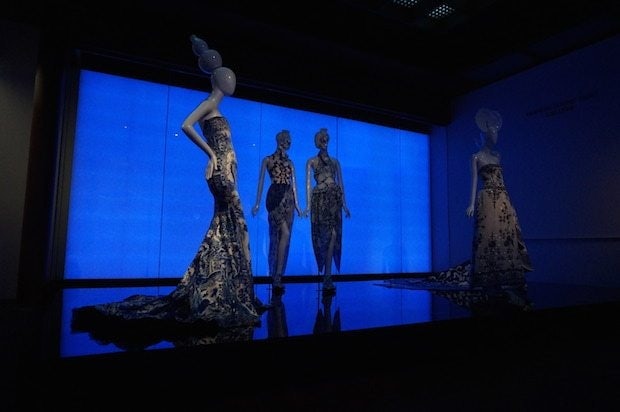
Gowns influenced by Chinese blue and white porcelain. (Cheryl Zhao/Jing Daily)
Why did the Costume Institute decide to focus mainly on Western designers rather than Chinese ones?#
I think our thesis was really Chinoiserie. I’d love to do a follow-up exhibition at some stage of Chinese costumes and the history of Chinese costumes and dress, and contemporary Chinese fashion. I think that’s a separate exhibition, but it would be something I’d love to follow up with, for sure.
How does the decision to incorporate film clips affect the way visitors experience the exhibit?#
I think it was pivotal in terms of the story I was trying to tell, because I think that a lot of designers who, when they think about China, they think about China through film. So they think about Bertolucci’s The Last Emperor, which has had an enormous influence on Western designers, and Wong Kar-wai’s In the Mood for Love, which is extraordinary. Even when you go to any designer, even if the collection’s not about China, there’s always an image from Wong Kar-wai’s In the Mood for Love. It had such a big impact on the Western imagination. In the exhibition, film is a bridge, in a way, between Western fashion and the Chinese objects with costumes on display. It sort of shows how designers see China through the lens of cinema.
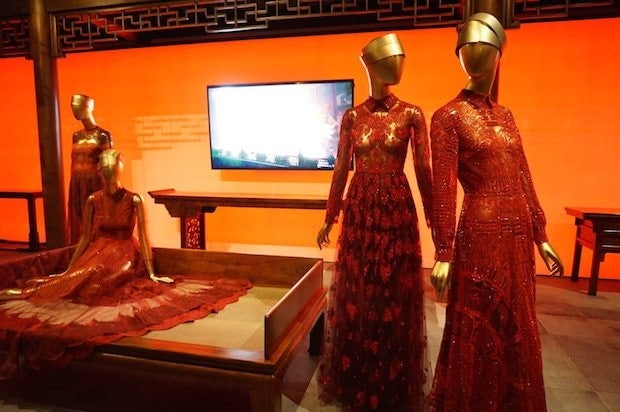
Red gowns on display at "China: Through the Looking Glass." (Cheryl Zhao/Jing Daily)
Several of the films that were said to inspire the designers are considered to have problematic racial stereotypes, such as the “dragon lady” trope in old Anna Mae Wong films. How does the Costume Institute address this issue in the exhibit?#
We present it head-on. We don’t hide it. We use Anna Mae Wong, actually. In one particular section of the exhibition, she was the first Chinese-American actress, who was often stereotyped in roles like the “dragon lady” or, on the flip side, the enigmatic oriental. To some extent, she actually left Hollywood and had to work in Europe because her acting career was curtailed by the roles she was forced to play. So we show a lot of those types of films—Daughter of the Dragon, Shanghai Express—films in which the directors are really focusing on racial stereotypes. It’s something that we present in the exhibition and discuss in the latent text.
What can visitors take away from viewing the designers’ pieces juxtaposed with Chinese antiques and art?#
I think they both offer different entries into what you’re seeing. For people who aren’t really knowledgable about fashion but are knowledgable about Chinese art, the art is a reference into the fashion and vice-versa. Our fashion community might not know too much about China, but we use the fashion as a way to talk about Chinese art. I think that when you look at them, they’re like these old friends meeting again. You’re creating these dialogues, and it opens up debate and interpretation, and that interpretation—again, it might be filled with half-truths; it might be filled with non-truths. Again, in a way, it fosters a debate. So I think the show, in a way, doesn't seek to answer any questions, to be honest. It does further the question of interpretation and communication.

The organizers of "China: Through the Looking Glass" including Andrew Bolton, Anna Wintour, Marissa Mayer, Wong Kar-wai, Silas Chou, and Wendi Murdoch at the Metropolitan Museum of Art's May 4 press preview. (Cheryl Zhao/Jing Daily)
Chinese consumers now represent the main customer base for most fashion and luxury brands. Do you think this will have any effect on the way designers use Chinese elements in their designs in the future?#
I think that it seems to be consistent in terms of when designers do engage with China, it’s a reductive matrix of the motifs that they engage with. I think that will be continued. It will be interesting to find out how they engage with contemporary China, because usually, their influence stops at the Communist period, or the Mao period. It will be interesting to see if they engage with China beyond that, and if they do, what are the motifs? What are the concepts that they engage with? So far, it’s been about China from the Mao back. It will be interesting to see when they do engage with contemporary China, what that engagement will be.
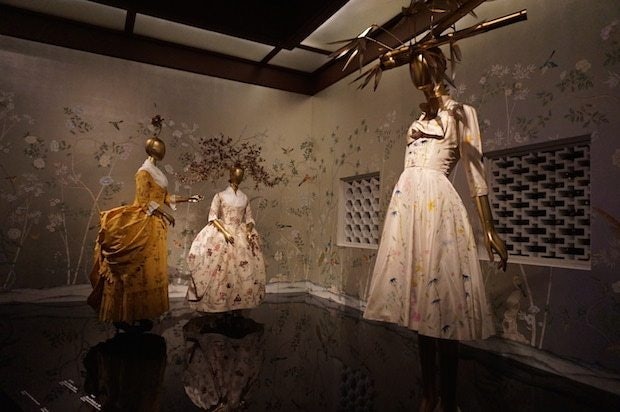
Gowns showing elements of Chinoiserie on display at "China: Through the Looking Glass." (Cheryl Zhao/Jing Daily)

Supermodel Liu Wen at the May 4 press preview for "China: Through the Looking Glass." (Cheryl Zhao/Jing Daily)
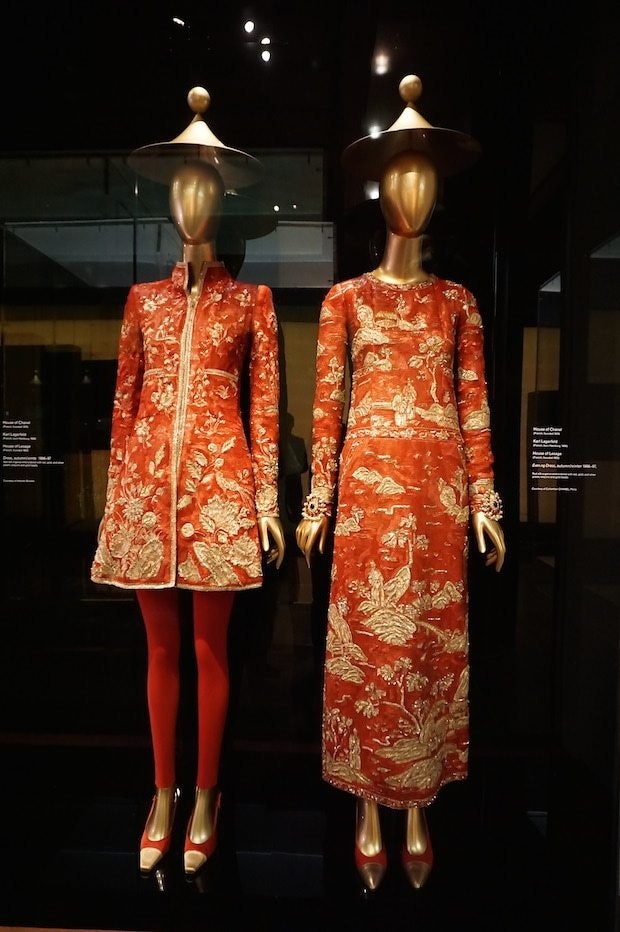
Chanel pieces on display at "China: Through the Looking Glass." (Cheryl Zhao/Jing Daily)
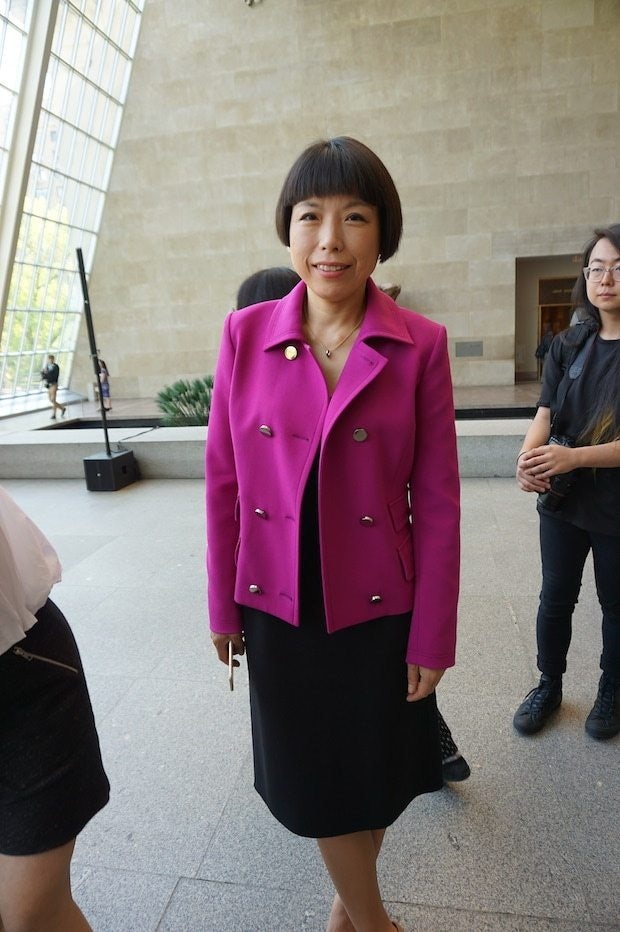
Vogue China Editor-in-Chief Angelica Cheung at the May 4 press preview. (Cheryl Zhao/Jing Daily)
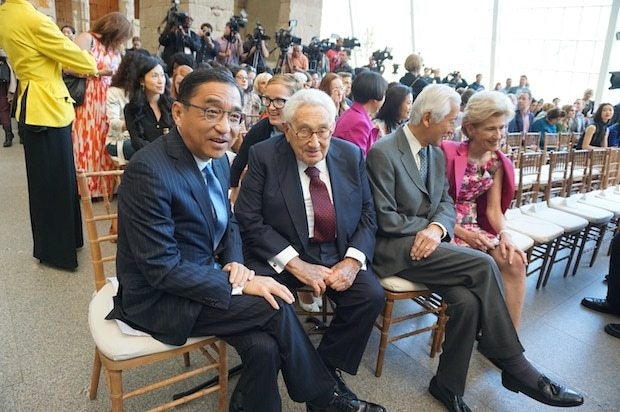
Silas Chou and Henry Kissinger at the May 4 press preview for "China: Through the Looking Glass." (Cheryl Zhao/Jing Daily)
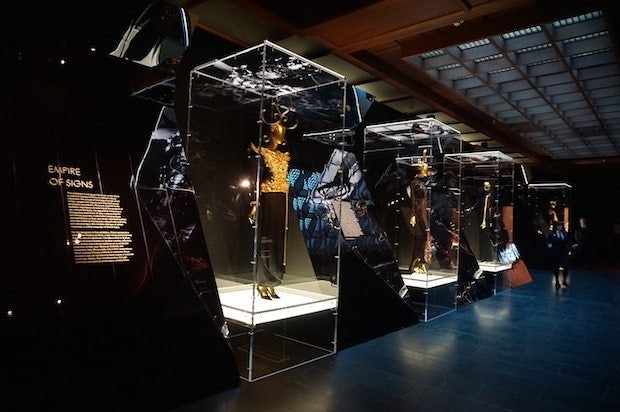
Pieces on display at the Costume Institute's "China: Through the Looking Glass." (Cheryl Zhao/Jing Daily)